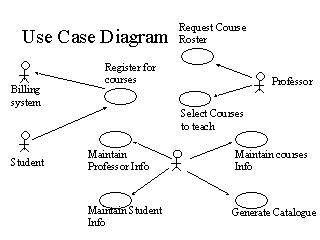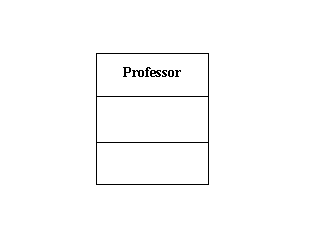OBJECT-ORIENTED
ANALYSIS AND DESIGN
Using UML
1. What Is the Unified Modeling Language ?
-
The Unified Modeling Language (UML) is describe in The Unified Modeling
Language for Object-Oriented Development written by Grandy Booch, Jim Rumbaugh,
and Ivar Jacobson.
-
Available from http:\\www.rational.com
-
Based on the authors’ personal experiences
-
Incorporates contributions from other methodologi
-
Co-submitted to the OMG by Rational Software, Miscrosoft, Hewlett-Packard,
Oracle, Texas Instruments, MCCI Systemhouse and others.
2. Inputs to UML

3. Evolution of the UML

4. Benefits of the Unified Modeling Language
-
Defines a seamless mapping from analysis to design to implementation
-
Defines an expressive and consistent notation
-
Makes it easier to communicate with others
-
Helps point out omissions and inconsistencies
-
Supports both small and large-scale analysis and design
5. Objectives: Iterative and Incremental Development
To be able to:
-
Define an iterative and incremental development process
-
List the phases, the products and the major activities for each phase of
an iterative and incremental development process
-
Define an iteration and list its activities
6. System Behavior
Objectives:System Behavior
You will be able to:
-
Define system behavior
-
Define use cases and actors
-
Understand how to document use cases
-
Use a use case diagram to show the actors, the use cases, and their interactions
-
Define scenarios for use cases
7. What is System Behavior?
-
System behavior is how a system acts and reacts
-
The outwardly visible and testable activity of a system
-
System behavior is captured in use cases
-
They describe the system, its environment, and the relationship between
the system and its environment
8. Major Concepts in Use Case Modeling

9. What is a Use-Case Model?
-
A use-case model is a model of the system’s intended functions (use cases)
and its surroundings (actors)
-
The same use-case model is used in requirements analysis, design and test
-
The use case model’s primary purpose is to communicate the system’s functionality
and behavior to the customer or end user
10. Benefits of a Use-Case Model
The use case model
-
Is used to communicate with the end users and domain experts
-
Provides buy-in at an early stage of system development
-
Insures a mutual understanding of the requirements
-
Is used to ideantify
-
Who will interact with the system and what the system should do
-
What interfaces the system should have
-
Is used to verify
-
All requirements are captured
-
That the developers have understood the requirements
11. Actors
-
Actors are not part of the system, they represent roles a user of the system
can play
-
An actor may actively interchange information with the system
-
An actor may be a passive recipient of information
-
An actor can represent a human, a machine or another system

12. Use Cases
-
A use case models a dialogue between actors and the system
-
A use case in initiated by an actor to invoke a certain functionality in
the system
-
A use case is a complete and meaningful flow of events.
-
Taken together, all use cases constitute all possible ways of using the
system

13. Sources of Information for Use Cases
-
System specification/problem statement
-
Domain relevant literature
-
Interviews with domain experts
-
Personal knowledge of the domain
-
Legacy systems
14. The Use Case Diagram
-
A use case diagram is drawn to illustrate that use cases and actors interacts
by sending stimuli to one another.


15. Use Case Documentation
Use cases are documented in
-
A brief description
-
The purpose of the use case in a few lines
-
Detailed flow of events
-
Description of the primary and alternate flow of events that occur when
the use is initiated
-
Documentation should read like a dialogue between the actor and the use
case
Both documents are written in terms the customer will understand
16. Objects and Classes
You will be able to :
-
Define and give example of objects
-
Define and give example of classes
-
Description the relationship between classes and objects
-
Define stereotypes
17. What is an Object?
-
Informally, an object represents an entity either physical, conceptual,
or software
-
An object is a concept, abstraction, or thing with sharp boundaries and
meaning for an application
-
An object is something that has :
18. An Objects Has State
-
The state of an object is one of the possible conditions in which an object
may exits
-
The state of an object normally changes over time
-
The state of an object is usually implemented by a set of properties (call
attributes),with the value of the properties, plus the link the object
may have with other objects
19. An Object Has Behavior
-
Behavior determines how an object acts and reacts
-
Behavior defines how an object reacts to requests from other objects
-
The visible behavior of an object is modeled by the set of messages it
can respond to(the operations the object can perform)
20. An Object Has Identity
-
Each objects has a unique identity, even if its state is identical to that
of another object
21. What are Classes ?
-
There are many objects identified for any domain
-
A class is a description of a group of object with common properties(attributes),
common behavior(operations), common relationships to other objects (associations
and aggregations), and common semantics
-
An object is an instance of a class
-
A class is an abstraction in that it:
-
Emphasizes relevant characteristics
-
Suppresses other characteristics
-
Abstraction help use deal with complexity
22. The Relationship Between Classes and Objects
-
A class is an abstracts definition of an object
-
It defines the structure and behavior of each object in the class
-
It serves as a template for creating objects
-
Object may be grouped into classes
23. Representing Classes
-
A class is represented using a compartmented rectangle

24. Class Compartments
A class is comprised of three sections
-
The first section contains the class name
-
The second section shows the structure(attributes)
-
The third section show the behavior (operations)
The second and third section may be suppressed if they need not be visible
on the diagram

25. Stereotypes
-
A stereotype is a new type of modeling element that extends the semantics
of the metamodel.
-
They must be based on existing types or classes in the metamodel
-
Every class may have at most one stereotype
-
Common stereotypes
-
Boundary class
-
Entity class
-
Control class
-
Exception class
-
Metaclass
-
Utility class
-
Stereotypes are shown in the class name compartment enclosed in <<
>>
26. Boundary Class
-
A boundary class models communication between the system’s surroundings
and its inner workings
-
Typical boundary classes
-
Windows(user interface)
-
Communication protocol(system interface)
-
Printer interface
-
Sensors
-
In the “Register for Courses” scenario, a Schedule Form is created to accept
information from boundary.
27. Interfaces to Other Systems
-
A boundary class is also used to model an interface to another system.
-
The important characteristics of this type of boundary class are:
-
The information to be passed to the other system
-
The communication protocol used to “talk” to the other system
-
In the “Register for Courses” scenario, information must be sent to the
external Billing System
-
A class called Billing System is created to hold the interface to the external
system.
28. Entity Class
-
An entity class models information and associated behavior that is generally
long-live(persistent)
-
It can reflect a real-life phenomenon
-
It may also be needed for the internal tasks of the system
-
The value of its attributes are often provided by an actor
-
The behavior is surroundings-independent
-
Entity classes in the “register for Courses “ ,use case
-
Course
-
Schedule
-
Catalogue
-
Course Roster
29. Control Class
-
A Control class model control behavior specific to one or more use cases
-
A control class
-
Create, initializes and deletes controlled objects
-
Control the sequencing or coordination of execution of controlled objects
-
Controls concurrency issues for controlled classes
-
Is, most of the time, the implementation of an intangible object
-
In the “Register for Courses” scenario, a Registration Manager class control
the registration process
30. Object Interaction
-
An interaction diagram is a graphical representation of interaction between
objects
-
There are two kinds of interaction diagrams
-
Sequence diagram
-
Collaboration diagrams
-
Each provides a different view of the same interaction
-
Sequence ->time order
-
Collaborations -> data flow
31. Sequence Diagram
-
A sequence diagram shows object interaction arrayed in time sequence
-
The diagram shows
-
The object participating in the interaction
-
The sequence of messages exchanges
-
A sequence diagram contains :
-
Objects with their lifelines
-
Message exchanged between object in ordered sequence
-
Focus of control(optional)

32.Collaboration Diagrams
-
A collaboration diagram is an alternate way to represent the messages exchanged
by a set of objects
-
The diagram shows object interactions organized around the objects and
their link to each other
-
A collaboration diagram contain :
-
Objects
-
Links between object
-
Message exchanged between objects
-
Data flowing between objects, if any
